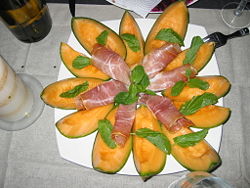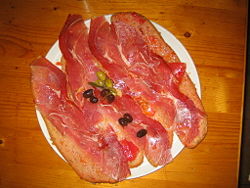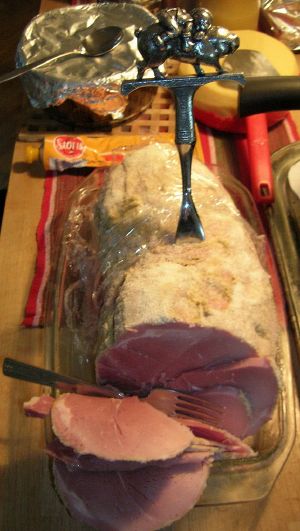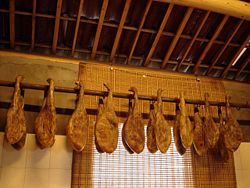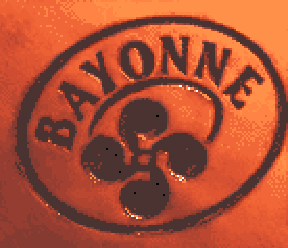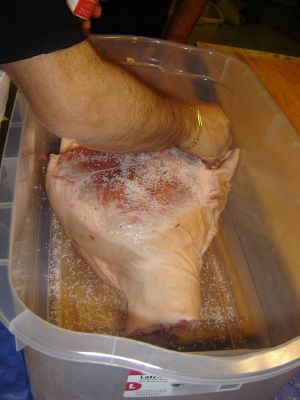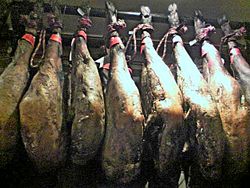Ham
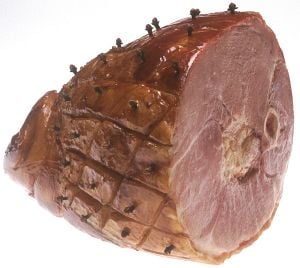
Ham is the thigh and rump of any animal that is slaughtered for meat, but the term is usually restricted to a cut of pork, the haunch of a pig or boar. Although it can be cooked and served fresh, most ham is cured in some fashion. Ham is a compact source of animal protein and an excellent source of calcium, iron, niacin, phosphorus, riboflavin, and thiamine. The curing process both preserves the meat allowing it to be stored, or brought on travels for consumption later, as well as giving it additional flavor. The distinctive flavor of particular varieties may come from the curing process or from the diet fed to the pigs.
Ham has been a common and popular meat throughout European and Asian civilizations, except where forbidden by religious prohibitions, and was introduced to the American continent by the first European settlers. Today, ham continues to be a favored food, with many regional varieties now available worldwide. While some faiths continue to prohibit eating ham, as a product of the pig, Christian holidays often feature ham as the main dish.
Preparation
Ham can either be dry-cured or wet-cured. A dry-cured ham has been rubbed in a mixture containing salt and a variety of other ingredients (most usually some proportion of sodium nitrate and sodium nitrite), Sugar is common in many dry cures in the United States. This is followed by a period of drying and ageing. Dry-cured hams may require a period of rehydration prior to consumption. A wet-cured ham has been cured with a brine, either by immersion or injection. The division between wet and dry cure is not always hard-and-fast as some ham curing methods begin wet but are followed by dry aging.
The majority of common wet-cured ham available in U.S. supermarkets is of the "city ham" variety,[citation needed] in which brine is injected into the meat for a very rapid curing suitable for mass market. Traditional wet curing requires immersing the ham in a brine for an extended period, often followed by light smoking. Traditional wet cured ham includes the English Wiltshire ham and the French Jambon de Paris.
Ham is also processed into other meat products such as Spam luncheon meat.
Use
Hams may be produced ready to eat or not. Fresh hams must be cooked by the consumer before eating. Ready-to-eat hams include prosciutto and cooked hams. Cooked, vacuum-packaged and canned hams can be eaten cold just as they come from their packaging. Such hams are often purchased sliced and are convenient for use in sandwiches. However, cooked hams can also be reheated, especially when whole, and served as the main dish in a meal.
Ham is served hot or cold in a variety of ways together with other food items such as bread, salad, cheese, and so forth, making it one of the most versatile meat sources of protein.
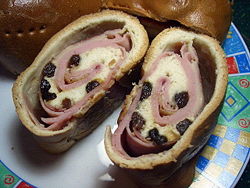
Cultural significance
Generally, the eating of any part of the pig, which includes ham, is forbidden in certain religions. The Jewish, Muslim and Rastafarian dietary laws prohibiting pork are known as Kashrut, Halal and Ital, respectively. Specifically, ham is not permitted for consumption by the Jain, Jewish, Muslim, Seventh-day Adventist and Rastafarian faiths.
On the other hand, Christians often eat ham at their religious holidays. Ham is a traditional dish served on Easter in predominantly Christian countries. A Christmas Ham or Yule Ham is a traditional dish associated with modern Christmas, Yule, and Scandinavian Jul.
The tradition of the Christmas ham is suggested to have began amongst the Germanic peoples as a tribute to Freyr, a god in Germanic Paganism associated with boars, harvest, and fertility.[1]
According to some folklorists and historians,[2] the origin of the Christmas ham in England comes from a:
tradition [that] was initiated in all probability on the Isle of Britain by the Anglo-Saxons, although our knowledge of it comes substantially from medieval times....[In ancient Norse tradition] sacrifice carried the intent of imploring Freyr to show favor to the new year. The boar's head with apple in mouth was carried into the banquet hall on a gold or silver dish to the sounds of trumpets and the songs of minstrels.[3]
Scandinavia and England, Saint Stephen may have inherited some of Freyr's legacy. His feast day is December 26 and thus he came to play a part in the Yuletide celebrations which were previously associated with Freyr. In old Swedish art, Stephen is shown as tending to horses and bringing a boar's head to a Yuletide banquet.[4] Both elements are extra-canonical and may be pagan survivals.
Regional variations
Ham is produced around the world, with regional variations on the method. Dry-cured varieties include Italian prosciutto crudo [proʃ'ʃut:to di 'parma] (prosciutto di Parma, prosciutto di San Daniele, prosciutto di Carpegna, prosciutto di Modena, prosciutto Toscano, prosciutto Veneto Berico-Euganeo, Valle d’Aosta Jambon de Bosses, prosciutto di Norcia) and the Spanish Jamon serrano and jamón ibérico. The United States has country ham, which might or might not be smoked. England has York ham and Wiltshire ham. Germany's Westphalian ham is usually smoked over juniper, in Belgium there is the dry-cured, smoked Ardennes ham. In Iran, the dry-cured Zard Kūh ham is produced.
Bulgaria
Elenski but (Bulgarian: еленски бут or (more precisely[5] but less commonly) бут по еленски, sometimes translated as Elena round or Elena leg) is a dry-cured ham from the town of Elena in northern Bulgaria and a popular delicacy throughout the country. The meat has a specific taste and can be preserved in the course of several years, owing much to the special process of making and the climatic conditions of the part of Stara Planina where Elena is located.
The legs and quarters of the pig, traditionally singed and scraped, are taken from the body. Later the redundant parts are removed, so that the remaining meat is protected by hide or the skin that surrounds the muscle tissue. After the legs are shaped, they are well salted and put at the bottom of a postav, a special type of barrel designed for the occasion. The delicacy traditionally remains in salt for 40 days, then is taken out and left to get dry.
There are various preservation technologies used to prepare elenski but that typically vary considerably from family to family, as opposed to regionally. In the past, the rounds were put in well trampled upon maize meal or processed with lime milk. The meat could also be stored in specially sewn bags of cheesecloth or wooden containers with thick nets instead of walls (muharnik), but is as a rule put somewhere airy, where the clear mountain air could aid the drying and conservation, and also in order to prevent houseflies to lay eggs on the rounds.
In many of the small towns around Elena, the rounds were in the past left in conservation in the rooms where the daily house fire was lit, so that a certain amount of smoking could be achieved in order to add flavor.
China
There are many unique ways of preparing ham in China and one particularly unconventional recipe was described in the book, Swallowing Clouds, by Anthony Zee. Hollows are dug in the side of a ham and filled with pieces of soft tofu. The filled ham is then spiced and cooked in an oven, but only the tofu is extracted and eaten while the actual ham is discarded. Ham is also eaten as a separate cured, salted, or smoked dish.
Jinhua ham is a type of dry-cured ham named after the city of Jinhua, where it is produced, in Zhejiang province of China. This type of ham has been known since the Song dynasty, and is highly regarded in Chinese cuisine. It may be eaten as part of a cold meat dish or used in producing soup stock, imparting its unique and umami flavour to any dish. Jinhua ham is an important ingredient in the dish Buddha jumps over the wall. The ham has been lauded in classical Chinese literature.
The ideal ham should have certain physical characteristics such as shiny and smooth yellow outside, a rounded shape in the style of a bamboo leaf, small joint and hoof, a thin and slender bone, an abundant layer of fat surrounding dark and red toned meat, a pronounced but not unpleasant odour, a fine textured meat with high levels of intramuscular fat, and a taste that is highly salty, umami and sweet. The outside of the ham may have small amounts of mold but this is considered normal and thought to contribute to the flavour of the ham.
France
Bayonne Ham or Jambon de Bayonne is an air dried salted ham that takes its name from the ancient port city of Bayonne in the far South West of France (Le Pays Basque or the Basque country). ar South West of France (Le Pays Basque or the Basque country).
The drying method used in modern times mimics that used in the past. Each drying storage chamber has temperature and humidity controls set to match seasonal variations. Originally the pigs were slaughtered in late October - early November. The hams were then rubbed in salt produced in the salt pans of the Adour estuary or from those near Bearn. The temperature conditions at this time of year, 6 to 8 °C, are ideal for the initial preserving process and the hams were left hanging in the drying room until the end of January or early February. In the next part of the process, a mixture of pork fat and flour called 'pannage' is used to seal the cut end of the joint. This reduces the speed in which the meat dries out during the warmer months of March, April, and May. At some point during this time many of the producers will also rub a paste of Piment d'Espelette into the skin, giving a unique tang to the end product. The final drying stage is completed by the end of July and the ham is ready. Modern techniques using individual drying chambers with temperature and humidity controls simply reproduce the seasonal temperatures and the changing humidity conditions produced each year by the 'foehn' (southerly wind) and the Atlantic ocean. The size of ham used is normally within the range of 8 to 9 kg including bone.
Once the ham has completed its curing process it is marked with the traditional "Croix Basque or Lauburu also known as the Basque Cross," topped with the name Bayonne. The ham is a minimum of 7 months old, with most being 9 or 10 months before it is offered for sale, and it will keep for up to another year if kept in a cool (8 °C), dry atmosphere. The result is a slightly sweet, delicately flavoured moist meat with very little salt to the taste, and if cut thinly, is almost translucent.
Jambon de Paris is a wet-cured, boneless ham and baked in shape. The ham is of superior quality product prepared from fresh, unfrozen pork thighs without adding polyphosphates.
Germany
- Black Forest ham, known as Schwarzwälder Schinken, is from the Black Forest region of Germany. It is seasoned, dry cured, then smoked over sawdust and fir brush. Black Forest ham, or Schwarzwälder Schinken in German, is a variety of smoked ham produced in the Black Forest region of Germany.
The production of Black Forest ham can take up to three months[6]. Raw ham is salted and seasoned with garlic, coriander, pepper, juniper berries and other spices. After curing for two weeks, the salt is removed and the ham cures for another two weeks.
Next, the ham is cold smoked at a temperature of 25° C (77° F) for several weeks, during which time the ham acquires its deep red color. The smoke is created by burning fir brush and sawdust. The smoking process gives the ham much of its flavor.
Black Forest ham has a very pronounced flavor and is common in German cuisine. It may be eaten fresh, for example on bread or with fruit, or used as an ingredient in cooked dishes.
- Westphalian ham is created from pigs raised in the Westphalian Forest and fed acorns. The resulting meat is dry cured and then smoked over a mixture of beechwood and juniper branches.
Italy
In Italy, ham is called prosciutto, and can be either raw (prosciutto crudo) or cooked (prosciutto cotto).
Earliest evidence of ham production in Italy comes from the Republican Roman period (400-300 B.C.E.).
Modern Italian and European Union legislation grants a protected designation of origin to several raw hams, which specify where and how these types of ham can be produced.
There are several such hams from Italy, each one with a peculiar production process. Parma ham, the so called Prosciutto di Parma, has almost 200 producers concentrated in the eastern part of Parma Province. Its production is regulated by a quality consortium that recognizes qualifying products with distinctive mark. Only larger fresh hams are used (12-13 kilograms). Curing uses relatively little salt, but can include garlic salt and sugar producing a sweeter meat. After salting, the meat is sealed with pig fat over the exposed muscle tissue, which slows drying. Curing occurs over a minimum 12 months. This curing method uses only salt, without nitrates and without spices. No conserving substances added. San Daniele ham (Prosciutto di San Daniele) is the most similar to Parma ham, especially the low quantity of salt added to the meat, and is the most prized ham. Other raw hams include the so called "nostrani" or "nazionali" or "toscani," they are more strongly flavoured and are produced using a higher quantity of salt.
Traditional prosciutto is cured for over 3 years. Bill Buford describes talking to an old Italian butcher who says:
“When I was young, there was one kind of prosciutto. It was made in the winter, by hand, and aged for two years. It was sweet when you smelled it. A profound perfume. Unmistakable. To age a prosciutto is a subtle business. If it’s too warm, the aging process never begins. The meat spoils. If it’s too dry, the meat is ruined. It needs to be damp but cool. The summer is too hot. In the winter—that's when you make salumi. Your prosciutto. Your soppressata. Your sausages.”[7]
Portugal
In Portugal, besides several varieties of wet-cured hams called fiambre (not to be confused with the Guatemalan dish, also called fiambre), the most important type of ham is presunto, a dry-cured ham similar to Spanish jamón and Italian prosciutto. There is a wide variety of presuntos in Portugal; among the most famous are presunto from Chaves and presunto from Alentejo (made from black iberian pig; see also pata negra).
Romania
In Romania, ham is called şuncă/şonc/jambon. Usually dry cured, always with granular salt, in Transilvania and Banat paprika might be added.
Spain
Jamón, in general English parlance, refers to a cured ham from Spain. There are two primary types of jamón: Jamón serrano (meaning ham from the sierra or mountains) and Jamón ibérico (ham from the Black Iberian Pig).
In Spanish jamón simply means ham, thus cooked sliced ham, for example, is called jamón de York. This is exactly the same as with the Italian prosciutto, which in Italy is any ham, in English is only dry-cured uncooked ham.
One of the more exacting ham regulatory practices can be found in Spain, where ham is called Jamón. Not only are hams classified according to preparation, but the pre-slaughter diet and region of preparation are considered important. Spanish ham is of two major varieties, Iberico and (Jamón serrano).
Iberico is at least 75% Black Iberian Pig, also called the cerdo negro or black pig, the only breed of pig that naturally seeks and eats mainly acorns. Spanish regulators recognize three types of Iberico ham qualities, labeled according to the pigs' diet, with an acorn diet being most desirable:
- Cebo or Campo hogs are fed only commercial feed.
- Recebo hogs are raised on commercial feed and fed acorns for the last few months of their lives.
- Bellota hogs are fed a diet almost exclusively of acorns (bellotas).
The term pata negra is also used to refer to jamón ibérico in general and may refer to any one of the above three types. Jamón ibérico, which only accounts for about 8% of Spain's cured-ham production, is very expensive and not widely available abroad.
Jamón serrano (literally mountain ham) is a type of jamón (dry-cured Spanish ham), which is generally served raw in thin slices, similar to the Italian prosciutto.
The fresh hams are trimmed and cleaned, then stacked and covered with salt for about two weeks in order to draw off excess moisture and preserve the meat from spoiling. The salt is then washed off and the hams are hung to dry for about six months. Finally, the hams are hung in a cool, dry place for six to eighteen months, depending on the climate, as well as the size and type of ham being cured. The drying sheds (secaderos) are usually built at higher elevations, which is why the ham is called mountain ham.
The majority of Serrano hams are made from Black Iberian Pigs, but are not to be confused with the much more expensive Jamón ibérico. These hams were known as a delicacy even in the days of the Roman Empire[8]. Though not expensive in Spain and the European Union, duties imposed on imported meats and exchange rates makes these hams more costly outside the Union.
The regional appellations of Spanish ham (Jamón serrano) include the following:
- Pedroches with Protected Denomination of Origin, from Córdoba (Andalusia).
- Huelva, a full-flavored ham produced in Huelva (Andalusia).
- Jabugo, a small village in Huelva bearing Spain's largest high quality ham industry.
- Guijuelo, Gredos and Béjar, from Salamanca (Castile).
- Extremadura, made in Cáceres and Badajoz.
- Cured ham of Trevélez, cured at least 1,200 meters above sea level. Cured hams from Trevélez are qualified to be among the “sweetest” cured hams due to the low degree of salting necessary for the drying and maturing processes to succeed properly. Mostly this is caused by the north winds coming from the high tips of Sierra Nevada.
- Teruel, cured at least 800 meters above sea level, with a minimum of a year of curing and aging (Serran Ham).
United States
In the United States, ham is regulated primarily on the basis of its cure and water content. The USDA recognizes the following categories:
Fresh ham is an uncured hind leg of pork. Country Ham is uncooked, cured, dried, smoked-or-unsmoked, made from a single piece of meat from the hind leg of a hog or from a single piece of meat from a pork shoulder. Smithfield ham, a country ham, must be grown and produced in or around Smithfield, Virginia, to be sold as such.
For most other purposes, under US law, a "ham" is a cured hind leg of pork that is at least 20.5% protein (not counting fat portions) and contains no added water. However, "ham" can be legally applied to such things as "turkey ham" if the meat is taken from the thigh of the animal. If the ham has less than 20.5% but is at least 18.5% protein, it can be called "ham with natural juices." A ham that is at least 17.0% protein and up to 10% added solution can be called "ham—water added." Finally, "ham and water product" refers to a cured hind leg of pork product that contains any amount of added water, although the label must indicate the percent added ingredients. If a ham has been cut into pieces and moulded, it must be labelled "sectioned and formed" or "chunked and formed."
In addition to the main categories, some processing choices can affect legal labelling. A 'smoked' ham must have been smoked by hanging over burning wood chips in a smokehouse, and a "hickory-smoked" ham must have been smoked over hickory. Injecting "smoke flavour" is not legal grounds for claiming the ham was "smoked." Hams can only be labelled "honey-cured" if honey was at least 50% of the sweetener used and has a discernible effect on flavour. So-called "lean" and "extra lean" hams must adhere to maximum levels of fat and cholesterol per 100 grams of product.
One of the most popular and expensive hams in the United States is Smithfield or Virginia ham. Through a special curing process Smithfield ham ages. In that time a fungal coat forms over the outside of the ham while the rest of the meat continues to age. This process produces a distinctive flavour, but the fungal layer must be scrubbed off of the ham before being cooked or served.
Turkey ham, a boneless product made from pressed dark meat,a popular low-fat alternative to traditional ham in the US.[9]
A spiral-slicing process has become popular for boneless hams sold by delicatessens in the US.[10]
Country ham is a variety of cured ham from the United States, associated with the Southern United States. It is typically very salty in taste.
Country hams are salt- and nitrate-cured for about a month and may be hardwood (usually hickory and red oak) smoked, then aged for several months to a year. Smoking is not legally mandated for making country ham. Some types of country ham (such as the "salt-and-pepper ham" of North Carolina) are not smoked. The smoking process turns the meat a much redder color than other hams. They are usually sold in stores unrefrigerated as whole bone-in hams packaged in rough cotton bags, with identifying markings printed on the bags. Country ham is also sold in ready-to-cook pre-soaked, pre-sliced packages, usually vacuum-packed plastic sheets.
Whole country hams must be scrubbed and soaked for many hours prior to consumption in order to remove the salt cure and mold, otherwise they will be much too salty to eat. Even when soaked properly, they are still quite salty. There are several methods of cooking a country ham. They include slicing and pan-frying, baking whole, and simmering for several hours (in several changes of water), followed by baking whole.
Country ham is often served in restaurants as an entree as a whole slice, often with the femur cross-section left in. It is also commonly served sliced and then cut into pieces to be used in sandwiches made of buttermilk (or similar) biscuits, sometimes with butter or red-eye gravy. The bone is obviously not left in for this preparation.
Red-eye gravy is closely associated with country ham, and is made by adding water or coffee to country ham pan drippings and cooking it down for a short time.
Country ham can be compared to prosciutto, but prosciutto is not smoked, and is generally moister than a country ham. It is also usually sliced much thinner instead of the thicker traditional country ham "steaks." Even country ham sliced to be used in a biscuit sandwich is cut thicker than prosciutto traditionally is.
Some cookbooks on Chinese cooking produced in the West suggest that country ham can substitute for Chinese ham products such as Jinhua ham, being similar in flavor.
Smithfield ham is a specific form of the country ham, a product which originated in the Town of Smithfield in Isle of Wight County in the Hampton Roads region of Virginia.
The history of Isle of Wight County and Smithfield are nearly as old as the settlement of the nation itself. In 1608, explorer Capt. John Smith visited the area south of his Jamestown Colony in search of food and trade with the Warascoyak Indians. The region’s first inhabitants took root in 1619, and the town of Smithfield was established in 1752. A culinary specialty of the area learned from the Native Americans was introduced to the rest of the world in the late 1700s—a salt-cured cut of pork later known as Smithfield Ham. The popularity of the ham grew, and everyone from royalty (Queen Victoria ordered hams frequently) to presidents have dined on the delicacy, making the quaint village of 6,500 “Ham Town U.S.A.”[11]
A 1926 Statute of Virginia (passed by the Virginia General Assembly) regulates the usage of the term "Smithfield Ham" by stating:
Genuine Smithfield hams [are those] cut from the carcasses of peanut-fed hogs, raised in the peanut-belt of the Commonwealth of Virginia or the State of North Carolina, and which are cured, treated, smoked, and processed in the town of Smithfield, in the Commonwealth of Virginia.
The peanut feed stipulation was removed in 1966. [12]
Notes
- ↑ Ellis Davidson, H.R. Gods And Myths Of Northern Europe (1965) ISBN 0140136274
- ↑ Edmund Kerchever Chambers, The Mediaeval Stage (1903, 257)
- ↑ James E. Spears, Folklore, 85, 3 (Autumn, 1974):194-198. JSTOR
- ↑ Pamela Berger, The Goddess Obscured: Transformation of the Grain Protectress from Goddess to Saint. (Boston, MA: Beacon Press, 1985, ISBN 0807067237) pp. 105-112.
- ↑ Bulgarians that are unfamiliar with the delicacy sometimes think, misled by its name, that it is prepared from venison and not pork. This is because the common meaning of the Bulgarian adjective elenski is deer's, while in this case it is used to denote the town of Elena. When the less popular name бут по еленски is used, this confusion is mostly eliminated.
- ↑ Description of production process taken from http://www.schwarzwaelder-schinken-verband.de/herstellung/index.html
- ↑ Buford, Bill Heat: An Amateur's Adventures as Kitchen Slave, Line Cook, Pasta-Maker, and Apprentice to a Dante-Quoting Butcher in Tuscany Knopf, 2006 ISBN 1-400-04120-1
- ↑ About Jamon Serrano Jamon.com
- ↑ Turkey Ham
- ↑ Patents & Press Releases: Benefits to the Franchisee of Logan Farms Spiral Slicing Technologies
- ↑ Patrich Evans-Hylton, Smithfield: Ham Capital of the World. (Arcadia Publishing, 2004)
- ↑ LIS > Code of Virginia > 3.1-867
ReferencesISBN links support NWE through referral fees
- Barrenechea, Teresa. The Cuisines of Spain. Ten Speed Press, 2005. ISBN 1580085156
- Berger, Pamela. The Goddess Obscured: Transformation of the Grain Protectress from Goddess to Saint. Boston, MA: Beacon Press, 1985. ISBN 0807067237
- Buford, Bill. Heat: An Amateur's Adventures as Kitchen Slave, Line Cook, Pasta-Maker, and Apprentice to a Dante-Quoting Butcher in Tuscany. Knopf, 2006. ISBN 1400041201
- Davidson, Ellis H.R. Gods And Myths Of Northern Europe. Penguin, 1965. ISBN 0140136274
- Evans-Hylton, Patrick. Smithfield: Ham Capital of the World. Arcadia Publishing, 2004. ISBN 978-0738517421
External links
- United States Department of Agriculture: Focus on Ham
- Ham Varieties and Terminology at About.com
- Iberian ham ForumForum in English,Spanish,French and Italian, about Iberian ham
Credits
New World Encyclopedia writers and editors rewrote and completed the Wikipedia article in accordance with New World Encyclopedia standards. This article abides by terms of the Creative Commons CC-by-sa 3.0 License (CC-by-sa), which may be used and disseminated with proper attribution. Credit is due under the terms of this license that can reference both the New World Encyclopedia contributors and the selfless volunteer contributors of the Wikimedia Foundation. To cite this article click here for a list of acceptable citing formats.The history of earlier contributions by wikipedians is accessible to researchers here:
The history of this article since it was imported to New World Encyclopedia:
Note: Some restrictions may apply to use of individual images which are separately licensed.
